Have you ever wondered what’s in a lipstick? Obviously there’s the colouring agents that make it red or pink, but what’s all the other stuff? Let’s talk lipstick science.
The video is here on YouTube, scroll down for the blog post version…
What makes a good lipstick?
First let’s talk about what a lipstick is. I mean, I think we all know what a lipstick is, but let’s break it down further.
Lipsticks are solid sticks that leave a coloured layer when you drag them across your skin. That means that if you really narrow it down to the very basics, the lipstick has to be:
- Solid at room temperature
- Hard enough not to break when you apply some force to it
- Soft enough that it’ll leave a layer on your skin when you drag it across
- That layer has to be evenly coloured
- That layer has to stay even for a while on your lips, which move around a lot and touch water
Lipstick ingredients
So here’s what we have in a lipstick to get all that to happen (long wear lipstick is a whole different beast – we’re just talking about the standard bullet-in-a-windup-tube version here):
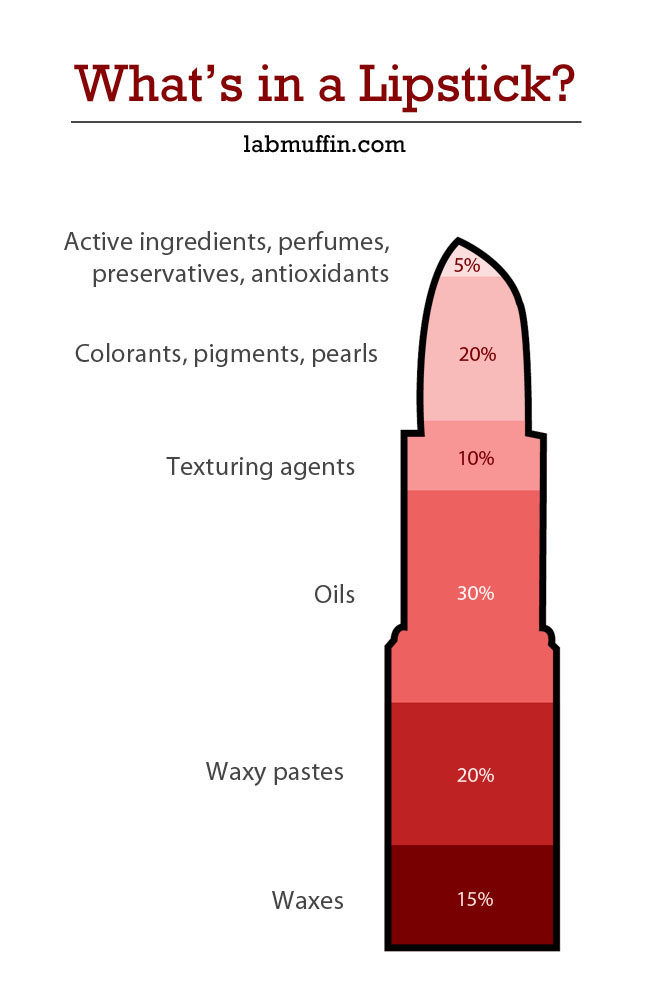
- Wax (around 15%)
- Waxy paste (20%)
- Oil (30%)
- Texturing agents (10%)
- Pigments and minerals (20%)
- Preserving agents and antioxidants (1%)
- Perfume (1%)
- UV filters and other actives
There’s a bit of variation with different brands, different finishes, different types, so these are just rough percentages, but I had to commit to a composition to make the diagram.
The base
Most of the lipstick is made of waxes and oils (some people divide these into a third category as well, waxy pastes), which form the base of the lipstick. This mix has to strike a good balance between being hard enough to stay solid and not break, while being soft enough to apply on your lips without too much effort. The oily substances in the base are water-repellent or hydrophobic, which is what keeps your lipstick on your lips – your lips are near a lot of water compared to the rest of your makeup.
The more solid ingredients are usually waxes. They’re sometimes called structuring agents, and they give the lipstick its solid structure. Common waxes found in lipstick and their melting points are carnauba (82 °C) and candelilla wax (mp 65-70 °C), beeswax (mp 63 °C), and ozokerite (mp 61 to 78 °C).
The higher the melting point, and the more wax there is, the harder the final lipstick (a general rule in chemistry is that the properties of a mixture reflect the properties of the components, with larger proportions meaning the mixture will have more properties of that substance – like how a cake with more butter will taste more buttery, and a cake with more sugar will taste more sugary).
Oils and waxy pastes soften the lipstick so it’ll actually apply, help spread the pigment, and make the lips smooth (by acting as an emollient moisturiser). There are lots of oil and waxy paste ingredients used in lipstick, including plant oils like castor oil, butters like shea butter, fatty esters like isostearyl isostearate, hydrocarbon-based ingredients like polybutene and mineral oil.
Oils also give a shiny finish, so matte lipsticks tend to have less of them, which is why matte lipsticks have a reputation for being less moisturising, and sometimes sucking all the moisture out of your lips. But the fact they have less oils means that they dry a bit harder and move around less, so they’re usually longer lasting.
An important aspect of the base mixture is that it needs to solidify into small microscopic crystals, not large chunky ones – this means you’ll get a smooth finish, and it means the lipstick won’t crack as easily because a small layer of lipstick can come off without taking a big chunk of the rest of the lipstick with it. If you see a grainy lipstick, this is usually the problem.
Another issue that can come up with a bad base mixture is sweating. This is when you get droplets on the surface of the lipstick, and this is usually because some of the base ingredients aren’t playing well together so some oil leaks out. Somes this happens in hot weather because the base melts a bit and then resolidifies, squeezing out some liquid oil.
Pigments
Pigments are probably what you think of first when you think of makeup ingredients. These are coloured powders which are dispersed in the rest of the lipstick, and give the lipstick its colour and opacity.
One of the important things about lipsticks is that it’s near your mouth. It’s one of the few makeup products that you will probably end up accidentally eating a bit, though not as much as fearmongering places would try to make you believe you eat. But that’s why some pigments aren’t allowed in lip products, or they’re limited to a certain concentration.
The pigment is dispersed into the oil, meaning that it usually doesn’t dissolve, but is ground up into tiny solid bits that are spread out into the lipstick base so it looks like it’s one continuous colour (sort of like protein powder in a protein shake – a really well-blended protein shake). You get a much nicer lipstick colour if the pigments are more ground up and more evenly spread in the base.
The colour additives are usually listed at the end of the ingredients list as a “may contain” section. Usually in a range the lipstick base is the same, and the pigments get changed, so this allows them to use the same ingredients list.
This is also related to why lipsticks with different finishes like matte and gloss aren’t usually in the same range, but different colours are. It’s relatively easy to change around the pigments around, but to change the finish you’d have to change the oils, which means the whole base would have to be tweaked.
Pigments you might’ve seen in lipstick are inorganic colours like iron oxides, organic colours and their lake versions which usually have names like Red 7 or Red 7 Lake, and carmine which is made from crushed beetles. You often see white pigments like zinc oxide and titanium dioxide too. These make the lipstick more opaque so it hides your natural lip colour, and the lipstick shade shows up more like how it looks in the tube.
Some lipsticks also have shimmery or mattifying effect pigments which change how the lipstick looks on the lips. For shimmery lipsticks, larger particles are use like mica, pearl, and bismuth oxychloride. For a matte finish, lipsticks might use silica or clay.
Preservatives, antioxidants, fragrance
On top of that, you also want the lipstick to stay good for longer, so you’ll have preservatives like parabens and phenoxyethanol that make it harder for bacteria and mould to grow on the lipstick. Antioxidants are also added to prevent oils and butters from going rancid, like vitamin E, BHA and BHT.
Sometimes the base can also have a funny smell or taste since they’re oils, and oils on their own can taste a bit weird especially if they’ve gone a little rancid. Fragrances and flavouring agents are added to cover this up.
Some lipsticks also have sunscreen actives to protect from UV, since lips are more sun sensitive, and active ingredients like in skincare.
This is just a basic overview – there are lots of other random things that need to be considered as well when a lipstick formula is being optimised. The lipstick might stick to the mould so it might need to be adjusted so it shrinks a bit as it hardens, and unsticks more easily. Pigment dispersants might have to be added to make the colour more even.
Hunting down a lipstick dupe
A lot of people have been asking me what lipstick I’m wearing in my videos – usually it’s Teeez Cosmetics Eve’s Ready to Wear Collection in Classy Caramel. It’s a really pretty brick colour with a super moisturising formula, and glides on smoothly.


Unfortunately it’s been discontinued for a while – I know it’s a bit gross but I still use it. In my defense, it contains ingredients that don’t go rancid easily or tend to encourage microbe growth – there are lots of inert hydrocarbons. It’s also been really difficult to find a replacement. The Teeez formula is incredibly moisturising, and it’s a bit of a dated 90s brick colour, which a lot of lipstick brands have discontinued (although given how many people have been asking me about it, it’s probably time they brought it back).
Ingredients: Pentaerythrityl Tetraisostearate, Octyldodecanol, Polyglyceryl-3 Diisostearate, Mica,
Polyethylene, Diisostearyl Malate, Octyldodecyl Stearoyl Stearate, Polybutene, Cera Microcristallina (Microcrystalline Wax), Synthetic Beeswax, Candelilla Cera (Euphorbia Cerifera (Candelilla) Wax), Parfum (Fragrance), Silica, Tocopheryl Acetate, Irvingia Gabonensis Kernel Butter, Hydrogenated Coco-glycerides, Tin Oxide, CI 77891 (Titanium Dioxide). May Contain: CI 77491 (Iron Oxide), CI 45410 (Red 28 Lake), CI 15850 (Red 6), CI 15985 (Yellow 6 Lake), CI 77492 (Iron Oxide), CI 77499 (Iron Oxide), CI 42090 (Blue 1 Lake), CI 15850 (Red 7 Lake).
So in the interests of being able to recommend a lipstick that other people could all get, and because it’s probably about time I replaced it, I went out to a bunch of stores to try to find a dupe. I swatched pretty much all of the potential lipsticks in Sephora and Mecca, and could only find one: Becca Ultimate Lipstick Love in Rouge.
This has a really nice creamy opaque formula, and comes in a nice magnetised luxe tube which gives satisfying pop and click sounds when you open and close it. It’s a bit less moisturising and doesn’t apply as smoothly on the lips (it drags a bit), but it’s really pigmented and leaves a pretty even stain after it wears off.
Ingredients: Ricinus Communis (Castor) Seed Oil, Diisostearyl Malate, Lanolin Oil, Caprylic/Capric Triglyceride, Trioctyldodecyl Citrate, Euphorbia Cerifera (Candelilla) Wax\Candelilla Cera\Cire De Candelilla, Octyldodecanol, Ozokerite, Bis-Diglyceryl Polyacyladipate-2, Silica, Hydrogenated Polydecene, Polyethylene, Microcrystalline Wax\Cera Microcristallina\Cire Microcristalline, Persea Gratissima (Avocado) Oil, Mangifera Indica (Mango) Seed Butter, Glycine Soja (Soybean) Seed Extract, Alumina, Ethylhexyl Palmitate, Tribehenin, Olea Europaea (Olive) Fruit Oil, Cholesterol, Linoleic Acid, Sodium Hyaluronate, Squalane, Tocopheryl Acetate, Phytosterols, Sorbitan Isostearate, Ceramide NP, Polydecene, Hydrogenated Castor Oil, Hordeum Vulgare (Barley) Extract\Extrait D’orge, Triticum Vulgare (Wheat) Germ Extract, Tin Oxide, Saccharin, Sorbitan Oleate, Palmitoyl Tripeptide-1, Ceramide NG, Fragrance (Parfum), Pentaerythrityl Tetra-Di-T-Butyl Hydroxyhydrocinnamate, [+/- Red 7 Lake (CI 15850), Iron Oxides (CI 77492), Iron Oxides (CI 77499), Titanium Dioxide (CI 77891), Blue 1 Lake (CI 42090), Mica, Yellow 5 Lake (CI 19140), Carmine (CI 75470), Iron Oxides (CI 77491), Yellow 6 Lake (CI 15985), Red 28 (CI 45410), Red 28 Lake (CI 45410), Red 30 (CI 73360), Red 30 Lake (CI 73360), Red 6 (CI 15850), Red 33 Lake (CI 17200)]
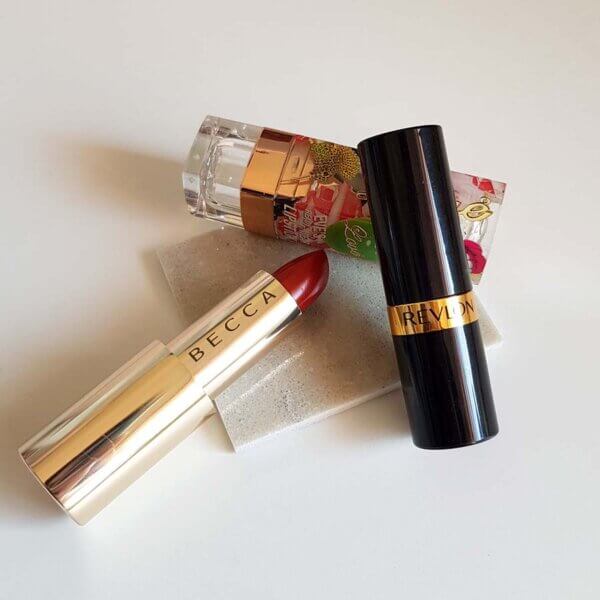
Revlon Super Lustrous Lipstick in Extra Spicy is another dupe, and I think this is a bit more moisturising than the Becca lipstick. Revlon are my favorite drugstore lipstick brand – their formulas work really well on my lips, and they apply easily. It’s more moisturising than the Becca lipstick, but less pigmented – it’s sort of in between the Becca and Teeez lipsticks.
Ingredients: Trioctyldodecyl Citrate, Ozokerite, Polybutene, Ethylhexyl Palmitate, Octyldodecyl Neopentanoate, Pentaerythrityl Tetraisostearate, C10-30 Cholesterol/Lanosterol Esters, Bis-Diglyceryl Polyacyladipate-2, Caprylic/Capric Triglyceride, Cera Microcristallina [(Microcrystalline Wax) Cire Microcristalline], Paraffin, Silica, Synthetic Fluorphlogopite, Calcium Sodium Borosilicate, Synthetic Wax, Tocopheryl Acetate, Ascorbyl Palmitate, Aloe Barbadensis Leaf Extract, Serica [(Silk Powder) Poudre De Soie], Pentaerythrityl Tetraethylhexanoate, Polyethylene, Ethylene/Propylene Copolymer, Palmitic Acid, Hydrogenated Polyisobutene, BHT, Benzoic Acid, May Contain: Mica, Titanium Dioxide (CI 77891), Iron Oxides (CI 77491, CI 77492, CI 77499), Red 33 Lake (CI 17200), Yellow 5 Lake (CI 19140), Yellow 6 Lake (CI 15985), Blue 1 Lake (CI 42090), Red 6 Lake (CI 15850), Red 7 Lake (CI 15850), Red 27 Lake (CI 45410), Bismuth Oxychloride (CI 77163), Carmine (CI 75470)
These lipsticks aren’t quite as moisturising and glossy as the Teeez Cosmetics one, so sometimes I’ll apply gloss on top. I’ve been using Revlon Super Lustrous Glass Shine in Rum Raisin, a really moisturising lipstick that’s almost like a lip balm, with a subtle colour. It’s good for casual wear if you don’t want to wear a fully opaque lipstick.
Ingredients: Polybutene, Diisostearyl Malate, Hydrogenated Polyisobutene, Diphenylsiloxy Phenyl Trimethicone, Bis-Diglyceryl Polyacyladipate-2, Octyldodecyl Neopentanoate, Hydrogenated Polydecene, Diisopropyl Dimer Dilinoleate, C10-30 Cholesterol/Lanosterol Esters, Ozokerite, Polyethylene, Synthetic Wax, Silica silylate, Aloe Barbadensis Leaf Extract, Sodium Hyaluronate, Quartz, BHT, Barium Sulfate, Butylene Glycol, Calcium Sodium Borosilicate, Caprylyl Glycol, Ethylhexyl Palmitate, Hexylene Glycol, Mica, Pentaerythrityl Tetraethylhexanoate, Silica Dimethyl Silylate, Parfum (Fragrance), Phenoxyethanol, Red 6 (CI 15850),Red 7 Lake (CI 15850),Titanium Dioxide (CI 77891),Yellow 5 Lake (CI 19140)
Some of the sales assistants recommended that I look at MAC’s range, since they tend to do nice 90s colours. Unfortunately they didn’t have a good match. MAC Chili is the same colour but with a matte finish. MAC Lustre Lipstick in Good Form over Auburn lipliner gave a similar effect to Classy Caramel, but I prefer using a lipstick only for easier reapplication.
Another lipstick I’ve been wearing a lot is Revlon Super Lustrous Lipstick in Toast of New York. It’s a similar rusty orange shade, but less intense, so it’s a bit lower maintenance and feels more comfortable for everyday wear. I’m wearing it in a few newer videos.
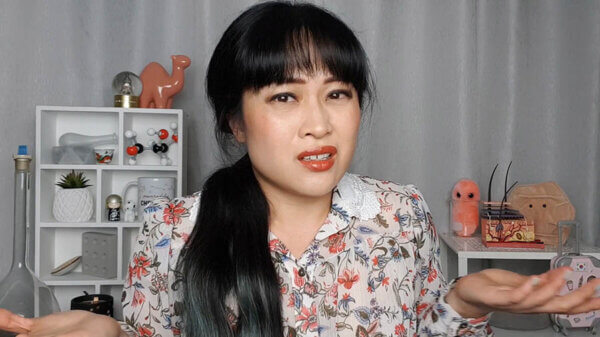
More Analysis of Specific Lipsticks
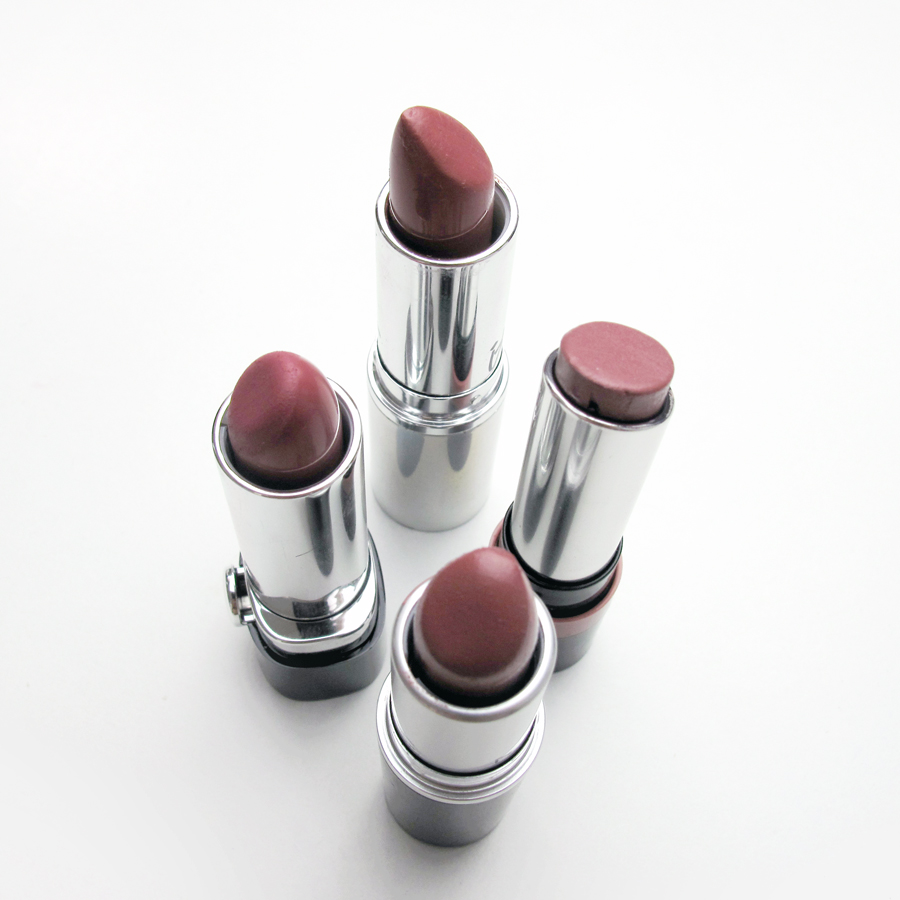
Here are ingredient analyses of some of the lipsticks I own, and how that relates to their properties. Ingredients lists are given in order from the highest proportion to the lowest, so you can eyeball which ingredients dominate. It’s worth keeping in mind, however, that the actual proportions can vary wildly – for example, an ingredients list stating “A, B” could have 51% A and 49% B; it could also have 99% A and 1% B.
The categorisations are a little approximate – “waxy paste”, for example, is something in between a wax and an oil, but the boundaries are pretty fuzzy, so it’s a little arbitrary. Sometimes an ingredient falls into more than one category, so I’ve just put it into the one I think is more important.
It’s also worth noting that a lot of ingredients aren’t put into a formulation for its properties – sometimes they’re just part of a mix that the formulator buys from an ingredient supplier. So be careful not to read too much into the ingredients list (I’m fully aware that my classifying the ingredients, that that’s exactly what I’m encouraging!). But I thought it would be quite interesting to see the general trends in what the lipstick contains, and how it functions.
REVLON LIP BUTTER
Polybutene (waxy paste), Bis-Diglyceryl Polyacyladipate-2 (waxy paste), Tridecyl Trimellitate (oil), Octyldodecanol (oil), Petrolatum (waxy paste), Hydrogenated Polydecene (oil), Neopentyl Glycol Diethylhexanoate (oil), Simmondsiachinensis (Jojoba) Seed Oil (oil), Polyethylene (thickener), Ozokerite (wax), Cetyl PEG/PPG-10/1 Dimethicone (emulsifier), Calcium Sodium Borosilicate (bulking agent), Calcium Aluminum Borosilicate (bulking agent), Hexyl Laurate (oil), Polyglyceryl-4 Isostearate (emulsifier), Cera Alba (Beeswax) (wax), Zinc Ricinoleate (antiviral?), Squalane (oil), Silica (colorant/thickener), Butyrospermumparkii (Shea Butter) (wax), Mangifera Indica (Mango) Seed Butter (wax), Palmitoyl Oligopeptide (antiaging), Tocopheryl Acetate (antioxidant), Cocos Nucifera (Coconut) Oil (oil), Synthetic Wax (wax), Ethylhexyl Palmitate (oil), Dimethicone/Bis-Isobutyl PPG-20 Crosspolymer (thickener), Isodecyl Neopentanoate (oil), Tribehenin (wax), Sorbitan Isostearate (emulsifier), Parfum (fragrance), BHT (antioxidant), Caprylyl Glycol (preservative), 1,2-Hexanediol (preservative). May Contain: Mica, Titanium Dioxide (CI 77891), Iron Oxides (CI 77491, 77492, 77499), Yellow 5 Lake (CI 19140), Red 7 Lake (CI 15850:1), Yellow 6 Lake(CI 15985), Red 33 Lake (CI 17200), Carmine (CI 75470), Blue 1 Lake (CI 42090), Red 6 Lake (CI 15850) (colorants)
Revlon Lip Butters are very soft, squishy lipsticks that are extremely moisturising and slippery. You can see that hard waxes don’t appear in the ingredients list until quite far down.
MAC TWIG
Ricinus Communis (Castor) Seed Oil (oil), Trioctyldodecyl Citrate (oil), Glyceryl Triacetyl Hydroxystearate (oil), Euphorbia Cerifera (Candelilla) Wax (wax), Octyldodecanol (oil), Silica (texturising/thickener), Simmondsia Chinensis (Jojoba) Seed Oil (oil), Beeswax (wax), Sesamum Indicum (Sesame) Oil (oil), Ozokerite (wax), Copernicia Cerifera (Carnauba) Wax (wax), Cetyl Ricinoleate (oil), Microcrystalline Wax (wax), Tocopherol (antioxidant), Ascorbyl Palmitate (antioxidant), Vanillin (fragrance), Alumina (bulking agent), Tin Oxide (bulking agent), Calcium Aluminum Borosilicate (bulking agent), Calcium Sodium Borosilicate (bulking agent). May Contain: Mica, Titanium Dioxide, Iron Oxides, Bismuth Oxychloride, Blue 1 Lake, Carmine, Red 6 Lake, Red 6, Red 7 Lake, Red 21, Red 21 Lake, Red 28 Lake, Red 30 Lake, Red 33 Lake, Yellow 5 Lake, Yellow 6 Lake, Yellow 10 Lake] (colorants)
MAC Twig is a satin finish lipstick. I’m guessing that’s why silica appears so high up, to provide the mattifying effect. I’ve found this to be quite drying on my lips – I think my lips just can’t handle too much castor oil.
RIMMEL KATE MOSS MATTE
Isononyl Isononanoate (oil), Ricinus Communis (Castor) Seed Oil (oil), Cetyl Ethylhexanoate (oil), Kaolin (texturising), Aluminum Starch Octenylsuccinate (texturising), Candelilla Cera/ Euphorbia Cerifera (Candelilla) Wax (wax), Ethylhexyl Palmitate (oil), Polyethylene (thickener), Ceresin (wax), Aqua/Water/Eau, Synthetic Fluorphlogopite (texturising/bulking agent), Calcium Aluminum Borosilicate (bulking agent), Copernicia Cerifera (Carnauba) Wax (wax), Caprylyl Glycol (preservative), Parfum/Fragrance (fragrance), HDI/Trimethylol Hexyllactone Crosspolymer (anti-caking agent), Silica (colorant/thickener), Tocopherol (antioxidant), Amethyst Powder (texturising), Diamond Powder (texturising), Ruby Powder (texturising), Sapphire Powder (texturising), Tin Oxide (bulking agent). May Contain: Mica, Titanium Dioxide (CI 77891), Iron Oxides (CI 77491, CI 77492, CI 77499), D&C Red No. 7 Calcium Lake (CI 15850), FD&C Yellow No. 6 Aluminum Lake (CI 15985), D&C Red No. 6 Barium Lake (CI 15850), FD&C Yellow No. 5 Aluminum Lake (CI 19140), D&C Red No. 27 Aluminum Lake (CI 45410), Carmine (CI 75470), D&C Red No. 33 Aluminum Lake (CI 17200), FD&C Blue No. 1 Aluminum Lake (CI 42090)(colorants)
Rimmel’s matte lipsticks use kaolin and aluminum starch octenylsuccinate to provide the matte effect. There’s some gem powders at the bottom of the list, likely for marketing purposes because they’re too far down to have much of an impact.
RIMMEL KATE MOSS CREME
Ricinus Communis (Castor) Seed Oil (oil), Euphorbia Cerifera (Candelilla) Wax (wax), Octyldodecanol (oil), Caprylic/ Capric Triglyceride (oil), Myristyl Lactate (oil), VP/Hexadecene Copolymer (film former), Ozokerite (wax), Lanolin (waxy paste), Castor Oil/IPDI Copolymer (film former), Meadowfoam Estolide (oil), Myristyl Myristate (oil), Parfum/Fragrance (fragrance), Silica (colorant/thickener), Benzyl Benzoate (oil/preservative), Di-PPG-3 Myristyl Ether Adipate (oil), Dipentaerythrityl Hexa C5-9 Acid Esters (oil), Sorbitan Sesquioleate (emulsifier), Tocopherol (antioxidant), Propylparaben (preservative), Copernicia Cerifera (Carnauba) Wax (wax), Diamond Powder (texturising), Ascorbyl Palmitate (antioxidant), Benzyl Salicylate (fragrance), Benzyl Cinnamate (fragrance), Linalool (fragrance), Aqua/Water/Eau, Chamomilla Recutita (Matricaria) Flower/Leaf Extract (antiinflammatory), Cucumis Sativus (Cucumber) Fruit Extract (antiinflammatory), Tin Oxide (bulking agent), Cinnamyl Alcohol (fragrance), Eugenol (fragrance). May Contain: Mica, Titanium Dioxide (CI 77891), D&C Red No. 7 Calcium Lake (CI 15850), D&C Red No. 6 Barium Lake (CI 15850), Iron Oxides (Ci77491, CI 77492, CI 77499), FD&C Yellow No. 5 Aluminum Lake (CI 19140), FD&C Yellow No. 6 Aluminum Lake (CI 15985), D&C Red No. 27 Aluminum Lake (CI 45410), D&C Red No. 6 (CI 15850), D&C Red No. 28 Aluminum Lake (CI 45410), D&C Red No. 33 Aluminum Lake (CI 17200), FD&C Blue No. 1 Aluminum Lake (CI 42090), Carmine (CI 75470) (colorants)
I was quite surprised to see that the creme version of the Kate Moss lipsticks has a completely different base to the mattes – I’m guessing the creme formula didn’t work with the mattifying agents. It’s interesting to see that the waxes appear higher for the creme than for the matte formula. My guess would be that the mattifying agents make the matte lipstick a bit harder, hence a lesser need for hardening waxes.
BURT’S BEES LIPSTICK
Diheptyl Succinate (oil), Ricinus Communis (Castor) Seed Oil (oil), Capryloyl Glycerin/Sebacic Acid Copolymer (oil), Cera Alba (Beeswax) (wax), Euphorbia Cerifera (Candelilla) Wax (wax), Helianthus Annuus (Sunflower) Seed Oil (oil), Behenyl Alcohol (wax), Oleic/Linoleic/Linolenic Polyglycerides (oil), C12-18 Acid Triglyceride (oil), Lanolin (waxy paste), Hydrogenated Vegetable Oil (oil), Copernicia Cerifera (Carnauba) Wax (wax), Moringa Oleifera Seed Oil, Rubus Idaeus (Raspberry) Seed Oil (antioxidant), Sorbitan Tristearate (emulsifier), Glyceryl Caprylate (emulsifier), Aroma (flavour), Tocopherol (antioxidant), Glycine Soja (Soybean) Oil (oil), Lauroyl Lysine (oil), Citric Acid (pH adjuster), Linalool (fragrance). May Contain: Mica, CI 77891 (Titanium Dioxide), CI 75470 (Carmine), CI 77491/CI 77492/CI 77499 (Iron Oxides) (colorants)
Burt’s Bees Lipsticks are the most moisturising “natural” lipsticks I’ve tried. I think it’s because they use a large amount of diheptyl succinate, a silicone-like oil with a smooth glide, instead of just having sticky castor oil as the main ingredient.
FACE OF AUSTRALIA GLOSSY LIP CRAYON
Ethylhexyl Palmitate (oil), Mineral Oil (oil), Carnauba Wax (wax), Isostearyl Isostearate (oil), Polybutene (waxy paste), Beeswax (wax), Ceresin (wax), Petrolatum (waxy paste), Pentaerythrityl Tetraisostearate (wax), Synthetic Wax (wax). May Contain: Mica (CI 77019), Titanium Dioxide (CI 77891), Red 7 Lake (CI 15850), Red 27 Lake (CI 45410), Red 6 Lake (CI 15850), Blue 1 Lake (CI 42090), Red 40 Lake (CI 16035), Yellow 5 Lake (CI 19140), Yellow 6 Lake (CI 15985),Red 33 Lake (CI 17200), Iron Oxides (CI 77489, CI 77491, CI 77492, CI 77499) (colorants)
These lip crayons are very moisturising. They come packaged in a wind up crayon, so they’re a bit harder than Revlon’s Lip Butters, but they’re still quite soft – I’m guessing there’s a fair bit more ethylhexyl palmitate and mineral oil than carnauba wax in this formula.
References
C Heusèle, H Cantin and F Bonté, Lips and Lipsticks, in Cosmetic Dermatology: Products and Procedures (ed ZD Draelos) 2010, Wiley-Blackwell, Oxford, UK. DOI: 10.1002/9781444317657.ch24
R Mallon, N Ripamonti and N Williams O’Hanlon, Lipsticks: how they have changed and where they are going, Cosmetics and Toiletries 2014.


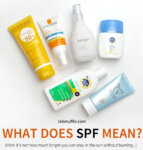


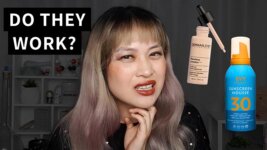
This is so interesting! Thanks for the post.
Loved this! It was really interesting learning about how the different ingredients impacted the formula of the lipstick. I totally agree that the gem powders in Rimmel’s lipsticks are just for marketing, I’m surprised they haven’t advertised that more.
Oh what a neat post! Thanks!
I formulate b&b and use castor oil a lot. It’s quite moisturizing and not sticky as a lot of people seem to think. A lot of these bulking and thickening agents are what is drying in the lipstick formulas. Castor is used quite frequently in bath bombs to soften skin. I’m quite glad to read all of your lipstick reviews. I am always in search of that perfect one. I think I’m off to the mall for the Raspberry!
What gives some lipsticks their staying power such as the 8 hour variety? Nothing ever stays on my lips, not even the so called long stay 🙁
Generally the lipstick forms a polymer film on the lips. I have a longwear lipstick science post in the works!
Hi!
Love the this post! I have. Been playing around with making natural lipsticks. What wax or ingredigent would make color show on the lips? I have a smooth formula but it applies as like a sheer balm on the lips no matter how much mica I use. Any suggestions?
Love and light,
Marie
I would guess perhaps pigments that are insoluble, rather than dyes? Something like titanium dioxide or carmine…
This article is so interesting, I’ve always wondered what is in lipstick.
Is ingesting lipstick harmful in any way?
Thank you very much,
Sue
I love reading your posts.
I wanted to let you know that Zinc Ricinoleate can be used as an odor neutralizer. I use it when I make hunting spray.
I recently read something that indicated that lipsticks could potentially contain gluten, which concerned me because I had to go gluten-free this summer. I really appreciated this post because it gave me the opportunity to read ingredients from several brands in one place, and am reassured that none of them listed anything that implied gluten as far as I could tell.
i m running a department which manufacturing lipsticks in matte,,, also glossy,,,,but during production air vent marks comes at their outer surface,,,,please help me
Love it! Please do more makeup scienceee
Thank you for this article ! Most lipsticks I tried have always left my lips incredibly dry and peeling (including Burt’s Bees). They also tend to form like a gross layer after an hour of applying that breaks apart and peels off. I have tried both “natural” lipsticks and drugstore-bought lipsticks. Is there a reason why that happens?
This post is very usefull to me.
I have a doubt. What is texturing agent?
Can you please tell me?
Thank you